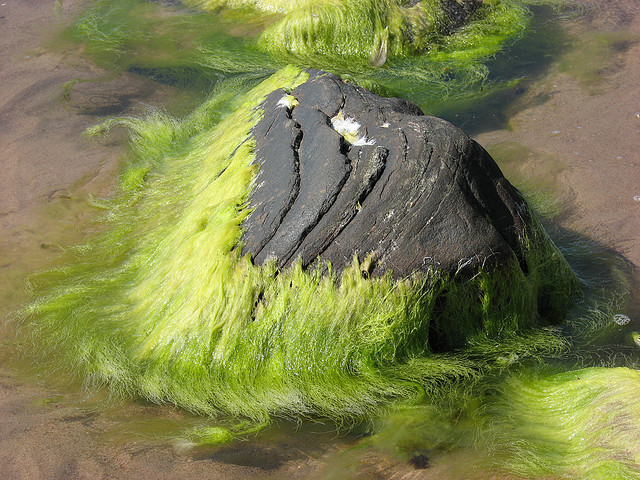Podcast: Play in new window | Download
Subscribe: RSS
Toxic Green Slime Attacks America! What a great movie pitch! Awesome special effects! Multitudes of bikini-clad victims! Unfortunately, it’s true, so hardly anybody is interested. This summer, 21 states that we know of — most don’t even bother to keep records on this pestilence — closed beaches and issued public-health warnings when their waters became clogged with blooms of toxic green algae. At least one person and 20 pets have been killed by the slime, along with untold numbers of birds and wildlife. Yet no cable news network has gone wall-to-wall on this spreading, deadly threat — perhaps because there’s no mystery here. We know who the culprit is, and we know how to stop the threat.
Industrial agriculture soaks its fields with chemicals throughout the growing season and sometimes beyond. Much of these compounds wash off the fields into the streams, rivers, lakes and oceans (they are responsible for enormous dead zones, where nothing lives, at the mouths of most of the world’s large rivers). Synthetic fertilizer, especially, delivers the nutrients intended for land-based plants to water-based plants — algae. Thus stimulated, algae bloom, form thick mats that block the sunlight from the living things below. Then the mats die and in decomposing suck all the oxygen out of the water.
There is one thing that algae love as much as the nitrates and phosphorous that industrial agriculture is feeding them; warm, stagnant water. And thanks to global warming, brought to us by the oil industry, algae are getting lots of that, too. The results are detailed in a report put out in September by the National Wildlife Federation.
But wait there’s more! Some of the algae in the scenario just described are cyanobacteria, or blue-green algae, that produce deadly toxins. The more algae you have, the more toxic algae, and thanks to industrial agriculture we have lots of algae. (In every story I see about this, some editor requires the insertion of an obligatory sharing of the blame with things such as lawn fertilizer, and the mythical “failing” rural septic systems. No such editor works here.)
A sampling of the havoc recently wreaked by the toxic green blobs:
-
The lakes in Iowa, the heart of the industrial breadbasket, have some of the highest nitrogen and phosphorus levels in the world. Because of algae blooms and poor water clarity, 79 of the state’s top recreational lakes are on Iowa’s impaired waters list.”
-
Grand Lake St. Mary’s in Ohio has spent $8 million since 2009 removing green slime that has cropped up May through October. [See “Ohio Lake Dying: Governor Applies Lipstick”]
-
In southeast Florida, the St. Lucie River and Indian River Lagoon were choked with algae this summer, and the state Department of Health warned residents to avoid it.
-
A massive algal bloom in southwest Florida killed a record 241 of Florida’s endangered manatees. There are only about 5,000 manatees left in the wild.
-
On Lake Erie, whose massive summer algae bloom can be seen from space, the city of Toledo, fourth largest in Ohio, will spend an extra $1 million this year to combat the toxins in its drinking water. [See “Zombie Lake Erie is Dying Again.”]
-
In Carroll Township, Ohio, west of Toledo, toxins in the water supply increased so much in early September that officials told 2,000 residents not to make any use of the water coming from their taps.
But wait there’s more! People eating shellfish taken from Northwestern waters have begun coming down with diarrhetic shellfish poisoning. Shellfish are filter feeders, and one of the things they filter out and retain are the toxins produced by algae. Pretty soon the rule will be: don’t eat shellfish in any month that has letters in its name. And don’t go anywhere near green water.
See also: Losing the War on Pond Scum
